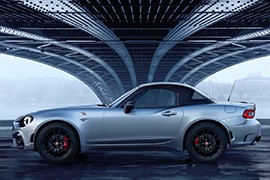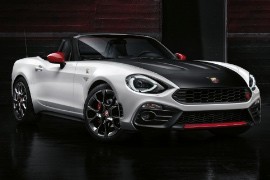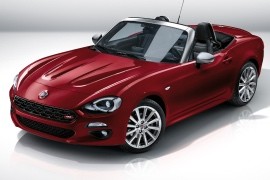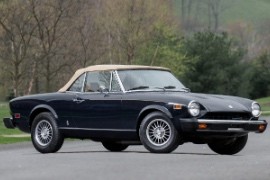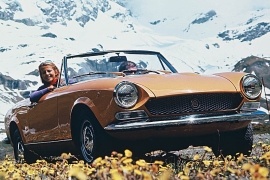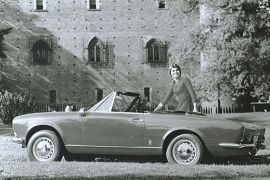FIAT 124 Spider Models/Series Timeline, Specifications & Photos
First production year: 1966
Engines: Gasoline
Body style: Convertible (spider/spyder, cabrio/cabriolet, drop/open/soft top)
The most sold roadster in the world received an Italian heart and a different face that transformed it from a Mazda MX5/Miata into a Fiat 124 Abarth.
The Mazda MX5/Miata was a long time champion as the most sold roadster in the world, long time after the original Fiat 124 Abarth was a glorious name on the car arena. Fiat and Mazda joined their forces and developed a car that could have been offered as an MX5 or as a 124 Abarth. It was something more than just a badge-engineering.
From the exterior, the round headlights and wide grille resembled the original Fiat 124 Spider from 1966 styled by Pininfarina. The classic look of the car was different than the one on the Miata, which was styled by Masashi Nakayama. The low beltline and the almost vertical A-pillars gave the car a simple, clean aspect. In the back, the 124 GT Abarth featured four exhausts on the sides and a diffuser under the bumper.
Inside, the Italian cousin of the MX5 featured Recaro sport-bucket seats, but most of the interior was carried-over from the Japanese model. Both cars were built in Japan, in a Mazda factory. The instrument cluster was slightly different, with a big and red tachometer in the middle. The car didn't feature a power-roof. It was manual, but it needed less than 5 seconds to open or close it.
Under the hood, the Fiat 124 GT Abarth featured a different engine than the Japanese version. It featured a 1.4-liter turbocharged engine and it produced more torque and more power than the MX5. Moreover, the gearbox was different, even though it was a 6-speed as well.
Developed as a performance version of the Fiat 124, the Abarth 124 brought more stamina and race-inspired elements to the Japanese-Italian roadster.
As Fiat's motorsports department, Abarth improved the Fiat 124 so that the car could please enthusiasts willing to drive a cheap, affordable, daily-driver open-top vehicle. So, despite the small engine under the hood, the "scorpion team" created an even better, faster car. In addition, it took care of aesthetics too.
The Italian specialist created a new front bumper design with unique air-intakes in the middle flanked by a pair of scoops on the sides. These were studied in the wind tunnel together with the diffuser in the rear bumper, so it could create a better aerodynamic. Just like its Fiat sibling, the Abarth 124 featured LED daytime running lights mounted inside the headlamps. The red and black colors dominated the car's front fascia, while the windshield's rim was finished in "Forgiato Grey." The little roadster's profile revealed its balanced proportions and the Abarth-specific 17" light-alloy wheels.
Both 124 and Miata shared similar interiors, so Abarth didn't have too much room for improvement. Still, it did its job by applying Alcantara trims on the dashboard and center armrest. In addition, a unique, leather-wrapped, three-spoke steering wheel was fitted. Moreover, the high-bolstered seats were leather-clad, with contrast stitching.
But Abarth's most essential challenge was to improve the car's dynamic. So apart from tuning the engine to provide more power than the Fiat version, it worked on the suspension. It also fitted a standard self-locking differential, so those who were enjoying drifts could do that better. After all, it was a Miata chassis underneath.
Fiat introduced the 124 Spider in 2016 as a successor for the glorious 124 model from the '70s, albeit it was mostly a non-Italian vehicle.
After the 2008 world financial crisis, all carmakers still had bruises and red areas in their accounting department. So Fiat tried to recover and did a marketing stunt by re-introducing the 124 Spider. But Fiat didn't have any platform to build the new successor, so it made a smart choice by calling Mazda. The Japanese carmaker had a proven record for producing the best-selling roadster in the world, the Miata. So after a deal was inked, production started.
Fiat needed just the vehicle's chassis and some parts of the bodywork since it already had a few engines that could fit neatly under the Miata's hood. Moreover, it had its own design team that completely changed the car's front fascia. Thus, the 124 Spider featured a pair of headlights that resembled those installed on its 1970's ancestor. In addition, the bumper sported a lower grille flanked by two side scoops where the blinkers and the foglamps were installed. Finally, out back, Fiat created a new design with different taillights than the MX5/Miata.
On the other hand, the cockpit was 99% Mazda, and the 1 percent difference was the Fiat logo on the steering wheel. But that wasn't bad since the Japanese carmaker knew how to create an adequate cabin for a roadster. The high-bolstered seats provided excellent side support for high-speed cornering maneuvers, and the infotainment screen was placed on top of the center stack.
Under the hood, Fiat ditched the naturally-aspirated 2.0-liter powerplant produced by Mazda and installed its 1.4-liter turbocharged unit. The gearboxes, instead, were Japanese, although they were carried over from an older generation of the MX5/Miata.
Fiat introduced a facelift for its small 124 Sport Spider in 1972. The Italian carmaker upgraded both the exterior and the interior of the car and installed more powerful engines.
Fiat launched the first 124 Spider in 1966 on the same base as the 124 Sedan and the 124 Coupe. While the earlier models were designed only for relaxed, not-so-fast driving, the car was improved over time and became faster. The Sport Spider and the Sport Coupe were developed for racing, and thus, the street versions received more power and different rear axle assembly to comply with the FIA regulations. And those were useful additions for the street versions.
The 1972 changes included a small revamp of the front fascia, which kept the same two round headlights. There was a new set of turn-signal lamps on the front fenders. A mesh-grille was installed instead of the older design with horizontal slats.
Inside, the two-seater featured a few updates. The instrument panel showed the same five dials, with a bigger speedometer and tachometer. Fiat installed a radio under the center of the dashboard to entertain its occupants in a center stack. Underneath it, there was the speaker and interior light, plus the cigarette lighter.
Under the hood, Fiat offered a wide choice of engines ranged between 1.6-liter and 2.0-liter, either carbureted or fuel injected. A significant upgrade was the five-speed manual gearbox.
Fiat had a good time back in the late '60s when it introduced the first facelift for the 124 Spider and installed a more powerful engine for the little two-seat roadster.
Roadsters were an excellent way to improve or to keep a brand's image high. With a high reputation of a carmaker that built vehicles priced for the masses, but with an emotional design, Fiat introduced the 124 Spider in 1966 as an open-top version for the 124 Coupe. Its first three years proved some flaws in the engineering design that forced the carmaker to act quickly and fix those issues. It took almost three years for the engineers to fix that, and only in 1969, they came with a solution to reinforce the transmission system. Along with the engineering upgrades, the design team made few modifications to the original design.
The 1969 124 Spider featured a mesh-grille instead of the original design with horizontal slats at the front. The designers modified the hood's look with the introduction of two bulges, suggesting that there was a V-engine installed. In the back, the taillights were bigger.
Inside, the carmaker installed two bucket seats at the front and a tiny bench in the rear, which decreased the tax income value. It was close to impossible to fit four people inside. The flat dash featured a glove-compartment on the passenger side and a five-dials instrument panel in front of the driver.
Fiat introduced a 1.6-liter engine under the hood from the 124 Sedan series and a new, 5-speed manual gearbox. Since it shared some mechanical components with the four-door sibling, it took the disc brakes in all corners that helped the car stops better.
Fiat tried to make its appearance in the convertible market when it introduced the 124 Spider, and the result exceeded its expectations.
The Italian carmaker tried to expand its lineup and conquer the American customers. It noticed the U.S. market appetite for open-top vehicles and attempted to make an affordable, fun to drive one. But it had to be a stunner and a real daily driver. For that, it hired Pininfarina Studios and offered them a free hand in developing the car.
It was an excellent result. Pininfarina discarded the Fiat 124 sedan shapes and used only its round headlights and the platform, but with a shorter wheelbase. Since it was aware that Fiat wouldn't place bigger engines under the hood, it made the car lighter by building it on an integrated chassis. It was a mix between a body-on-frame and unit-body construction. To keep some ties with the sedan version, Pininfarina made the grille with horizontal slats.
The carmaker asked the designer to make a two-seat roadster, and that's what Pininfarina provided. Its instrument panel showed five dials, with a bigger speedometer and tachometer. As an option, Fiat installed a radio in a center stack under the dashboard. Underneath it, there was the speaker and interior light, plus the cigarette lighter.
Under the hood, Fiat dropped a 1.4-liter engine carried over from the sedan version, which provided 90 hp thanks to its Weber carburetors. It paired it with a five-speed manual. It was an instant success, but the Italian carmaker understood that the roadster needed a bigger engine.
